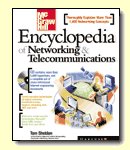|
Site home page
(news and notices)
Get alerts when Linktionary
is updated
Book updates and addendums

Get info about the Encyclopedia of Networking
and Telecommunicatons, 3rd edition (2001)

Download the electronic version of the Encyclopedia
of Networking, 2nd edition (1996). It's free!
Contribute to this site
Electronic licensing info
|
|
Redundancy
Related Entries Web Links New/Updated Information
Note: Many topics at this site are reduced versions of the text in "The Encyclopedia of Networking and Telecommunications." Search results will not be as extensive as a search of the book's CD-ROM.
In the world of computer networking, redundant methods are used to protect systems from failure, to protect data from loss and corruption, and to ensure that communication systems stay online and provide a required amount of performance. Some examples are given here:
- Backup and archiving is the most obvious form of redundancy. You create copies of files on alternate disks or backups. The backups are only used when the primary files are lost.
- CRC (cyclic redundancy check) is a method for detecting errors in transmitted data. See "Error Detection and Correction."
- Servers and networking equipment often contain redundant components, such as power supplies, processors, interface cards, and even switching fabrics. If one component goes bad, the redundant component can keep the system up and running. In clustered systems, entire servers and disk systems are duplicated. See "Fault Tolerance and High Availability."
- Redundant power supplies such as battery backup systems or power generators are another form of redundancy. See "Power and Grounding Problems and Solutions."
- RAID data storage systems are based on arrays of redundant disk drives in which data is stored on multiple drives simultaneously, thus providing fault tolerance. See "RAID (Redundant Arrays of Inexpensive Disks)."
- Real-time multimedia transmissions can suffer from excessive packet loss. Since the data is being displayed in real time, recovering a lost packet is usually not feasible. An alternative solution is to create and transmit redundant data streams. Then, if a packet is lost, the missing information may be reconstructed at the receiver from the redundant data that arrives in the following packet(s). See "Multimedia."
- Communication links may be duplicated to provide "on-demand" bandwidth or failover in the event that a primary communication link fails. Link aggregation is a technique in which multiple links are bound together to appear as a single link with a bandwidth of all the links combined. See "Bandwidth on Demand" and "Link Aggregation."
- Load balancing puts redundant equipment such as switches, servers, and storage devices in Web sites and data centers to improve performance and to provide failover options.
Copyright (c) 2001 Tom Sheldon and Big Sur Multimedia.
All rights reserved under Pan American and International copyright conventions.

|

